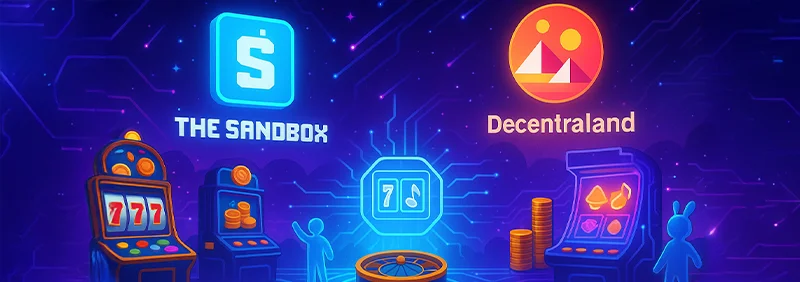Home > Casino Lab > Casino Web3 > Case Studies: The First Fully-Operational Metaverse Casinos
Case Studies: The First Fully-Operational Metaverse Casinos
The concept of Metaverse casinos has shifted rapidly from futuristic speculation to concrete reality. What was once a bold vision of 3D gambling hubs inside virtual worlds is now being tested and refined by pioneering platforms.
These first fully-operational Metaverse casinos provide a glimpse into how gambling will evolve when blockchain transparency, immersive VR environments, and player-driven economies intersect. By examining real-world case studies, we can understand both the opportunities and challenges of building casinos in digital universes.

Defining a Metaverse Casino
A Metaverse casino is more than just an online gambling platform. It is an interactive 3D environment where players log in with customizable avatars, walk across virtual casino floors, and interact socially while betting in real time.
Unlike traditional casinos, these platforms often integrate NFT-based ownership, cryptocurrency payments, and DAO-style governance, creating ecosystems where players are not just gamblers but also participants in the casino economy.
Case Study 1 – Decentraland’s Virtual Casino
One of the earliest and most high-profile examples of a Metaverse casino exists within Decentraland, a blockchain-powered virtual world. Here, operators have launched casinos where players wager cryptocurrencies such as MANA, Ethereum, or stablecoins. Games include roulette, poker, and slot machines, all presented in fully explorable 3D spaces.
Players can purchase NFT wearables for their avatars, participate in live events, and earn token rewards for activity. The case of Decentraland’s casino demonstrates how gambling can evolve into a social and lifestyle experience, where playing is combined with digital ownership and community engagement.
Case Study 2 – Sandbox Casino Experiments
Another example comes from The Sandbox, a virtual world known for its voxel-based environments. Several operators have experimented with casino spaces inside The Sandbox, offering blackjack, slot machines, and dice games powered by provably fair smart contracts.
The unique feature of Sandbox casinos is their integration with NFT land ownership. Players can buy virtual land adjacent to casino properties, creating a system where investors profit from the traffic and activity generated by these entertainment hubs. This blending of gaming, finance, and real estate makes Sandbox casinos a compelling prototype for future iGaming models.
Case Study 3 – VR-Exclusive Casino Platforms
Despite their potential, Metaverse casinos face significant hurdles. Regulation will be a major concern, as governments struggle to define legal frameworks for immersive and decentralized platforms.
Accessibility is another barrier—while VR technology is improving, it is not yet universally adopted, and mainstream audiences may be slow to embrace it. Finally, responsible gambling tools must evolve to match these new environments, ensuring that immersion does not lead to excessive play or addiction.
Beyond blockchain-based virtual worlds, standalone VR platforms are experimenting with casino spaces that emphasize realism and immersion. These casinos, often accessible with Oculus or similar headsets, allow players to sit at lifelike poker tables, interact with AI-driven dealers, and even replicate the atmosphere of Las Vegas or Monte Carlo.
While still in their infancy, VR-exclusive casinos highlight the immersive potential of Metaverse gambling, where the line between virtual and physical casino experiences begins to blur.
Opportunities and Challenges
The first operational Metaverse casinos showcase enormous potential, but they also face challenges. Opportunities include global accessibility, community-driven ownership, and endless design creativity. A Metaverse casino can exist in space stations, fantasy kingdoms, or futuristic cities—settings impossible in the physical world.
On the other hand, regulatory issues remain unresolved. Many jurisdictions are uncertain how to classify gambling in virtual worlds, especially when casinos are owned collectively through DAOs. Technical barriers such as the cost of VR hardware, the learning curve of blockchain, and the scalability of platforms also limit adoption.
Conclusion
The first case studies of Metaverse casinos demonstrate that the future of gambling is already here. From Decentraland’s crypto-based venues to Sandbox’s NFT-powered spaces and VR-exclusive platforms, these pioneering projects show how iGaming can evolve into a fully immersive, community-driven, and borderless industry. While regulatory and technical hurdles remain, the innovation on display proves that Metaverse casinos are not just a trend—they are the next frontier of online gambling.
The question is no longer if Metaverse casinos will succeed, but how fast they will redefine the iGaming landscape.
